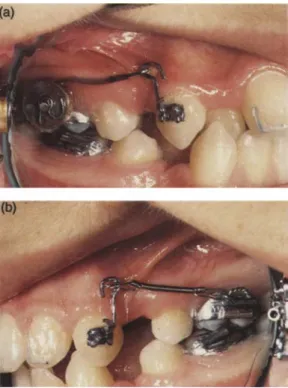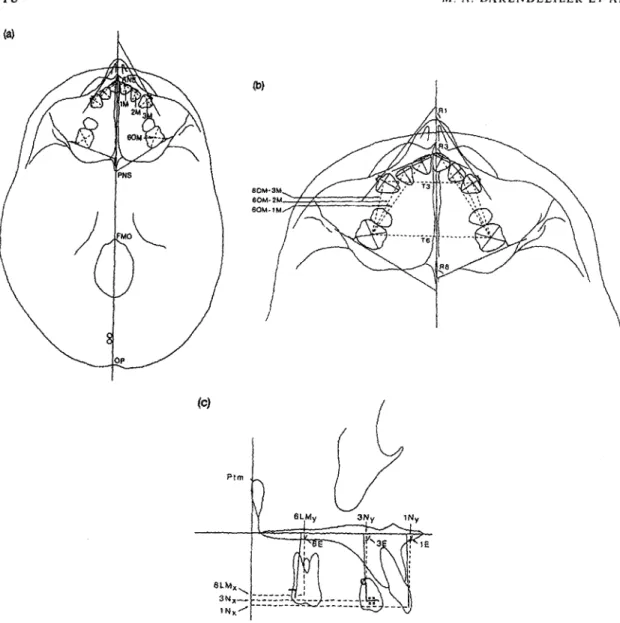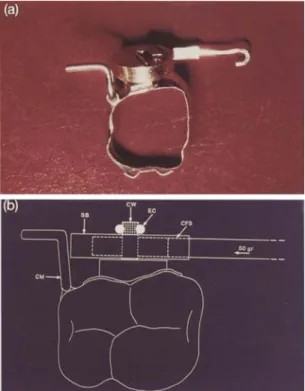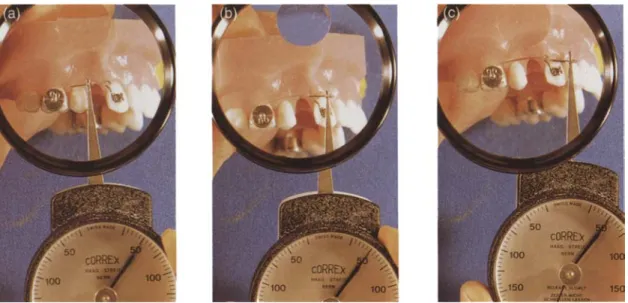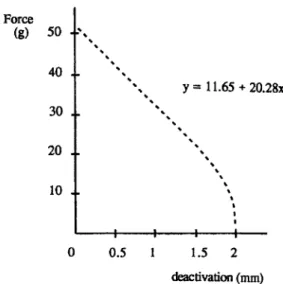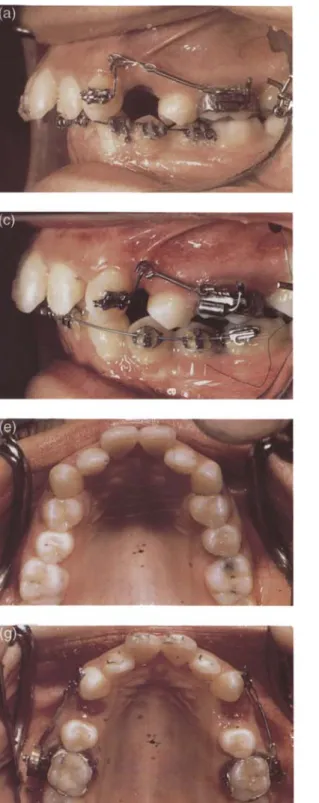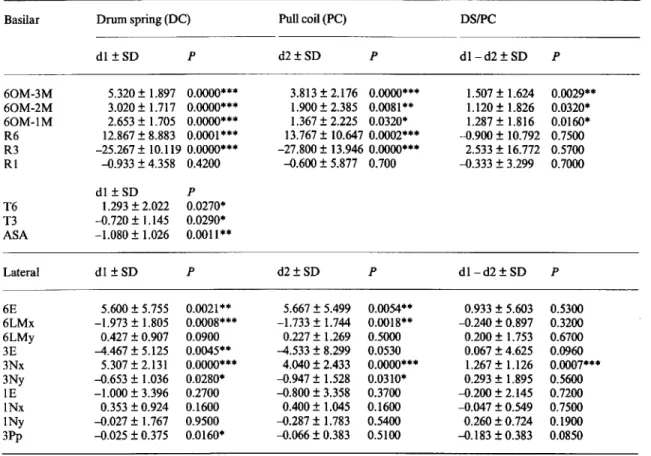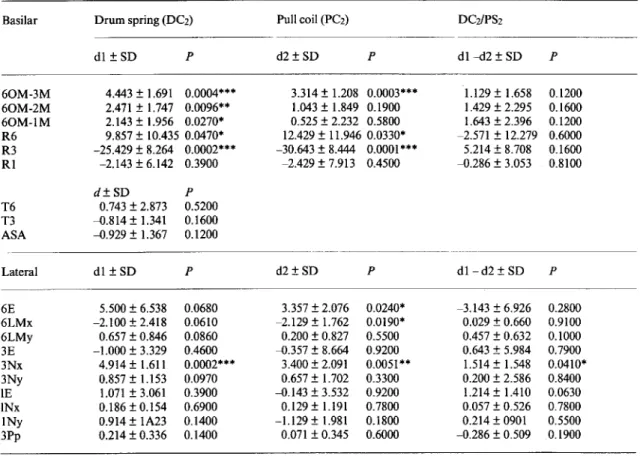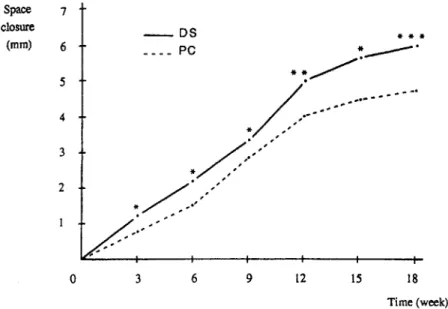The drum spring (DS) retractor: a constant and
continuous force for canine retraction
M. Ali Darendeliler,* Haluk Darendeliler** and Oktay Oner***
*Department of Orthodontics and Pedodontics, School of Dentistry, University of Geneva, Switzerland, **Mechanical Engineering Department, Middle East Technical University, Ankara and ***Department of Orthodontics, School of Dentistry, University of Gazi, Ankara, Turkey
SUMMARY Although much research has been undertaken on the rate of tooth movement, with different hypotheses having been put forward, the concepts of threshold, light, heavy and optimal forces are not still clear.
It has been stressed that an ideal orthodontic spring should have the ability to release a constant force throughout the entire range of its activation, but using traditional techniques applied initial force will decrease, depending on its deactivation due to the tooth movement and the physical properties of the force delivery system. The purpose of this study was to test the clinical use of a new and original spring, the drum spring (OS) retractor (developed in 1992), which applies a constant and continuous force without the need for reactivation, and to compare the effect of a constant and continuous force versus a continuous but diminishing force produced by a traditional pull coil (PC) retractor system on the rate of upper canine retraction.
The clinical sample consisted of 15 patients with upper first premolar extractions. For each patient, the upper right canine was retracted by using a OS retractor applying a constant and continuous force of 50 g; the upper left canine was fitted with a conventional PC applying an initial force of 50 g, diminishing proportionally with the distal movement of the canine. In addition, each group was divided according to the age of each patient: eight patients (three males, five females) between 11.8 and 14.4 years of age (mean 13± 1.2 years) represented the adolescent group, and seven patients (three males, four females) between 18.8 and 21.6 years of age (mean 18.2 ± 1.9 years) representing the adult group. The experimental period started 1 week after the extraction of the first premolars. Ouring this period no archwire was used, to avoid friction and force level changes, and the both springs were attached to a 6 mm hook fixed on the canine bracket to reduce tipping. The PC retractor was reactivated every 3 weeks whereas the OS retractor was left untouched over the entire experimental period. The study was continued until one of the two canines was completely retracted. The OS retractor was successful for space closure without any reactivation, and the continuous and constant force provided a more rapid canine movement than the continuous but diminishing force. Canine retraction occurred faster in adolescents than in adults. An entire field of clinical and research applications may be influenced by this new type of spring.
Introduction
Quantity as well as quality of orthodontic forces have been discussed for more than a century. 'Ideal tooth movement', 'limits of biological safety', patient comfort, duration and level of force, and mechanical factors have been investigated by many clinicians and researchers (Schwartz, 1932; Begg, 1956; Burstone et al., 1961; Reitan, 1967; Robertset al., 1981; Mostafa etal.,1983; Proffit, 1986; Miura etal.,1988).
Tooth movement is primarily a periodontal
membrane phenomenon and is a consequence of alveolar bone remodelling and bone turnover, which is generally thought to be related to biological factors (Mundy, 1987; Davidovitchet al.,1992; Robertset al.,1992), nutrition (Migrett et al., 1981; Collins and Sinclair, 1988), orthodontic force systems (Proffit, 1986; Roberts et al., 1992) and various local (maxilla versus mandible, tooth length and morphology, alveolar bone level) (Burstone, 1986; Roberts et al., 1992) and environmental factors (seasons,
al., 1995). Above all, orthodontic force systems have a direct influence on tooth movement and it is generally accepted that the biological safety is closely related to the amount of force applied (Reitan, 1967; Weinstein, 1967), the age of the patient and the cellular turnover of alveolar bone (Stutzmann et al., 1979; King et al., 1992).The basic idea is that because of root surface differences, an ideal force intensity that will move teeth at an optimal rate exists for each type of tooth and that several variables, such as force system, initial tooth displacement, stress, strain and biological changes of the periodontium, should be taken into consideration to obtain optimal tooth movements (Smith and Storey,
1952; Burstone et al., 1961;Tanne et al.,1992).
Different hypotheses have been put forward on stress magnitude and the rate of tooth movement, but the concepts of threshold, light, heavy and optimal forces are still not clear (Oppenheim, 1944; Smith and Storey, 1952;
Andreasen and Johnson,1967;Hixon et al.,1969, 1970;Boester and Johnston, 1974;Nikolai,1975;
Quinn and Yoshikawa,1985;Burstone, 1986).
Experimental studies have stressed the rate of hyalinization as a rate-limiting factor of ortho-dontic tooth movement. The application of light and continuous forces results in short hyaliniza-tion periods followed by direct bone resorphyaliniza-tion and relatively rapid tooth movement (Reitan,
1985).Itis also reported that orthodontic tooth movement is possible without an initial period of overcompression and hyalinization (Rygh et al.,
1986). Undoubtedly, it is not the absolute mag-nitude of the delivered force that is important but, rather, the distributed load or stress in the surrounding periodontal ligament (PDL) and resultant strain (Storey and Smith, 1952;
Burstone, 1986;Tanne et al.,1987).
Force constancy and continuity should also be taken into consideration in an optimal ortho-dontic force system (Burstone, 1986).Every type of force applied initially using traditional techniques will decrease depending on deactiva-tion due to tooth movement and the physical properties of the force delivery system. In other words, conventional force systems fail to deliver
materials (Miura et aI., 1988; Angolkar et al.,
1992).
Burstone et al. (1961) stressed that an ideal orthodontic spring should have the ability to release a constant force throughout the entire range of its activation. Proffit(1986) stated that 'only in theory is it possible to produce a perfect spring, one that can deliver the same continuous force day after day, no matter how much or how little the tooth moves in response to that force'.
The purpose of this study was to test the clinical use of a new and original spring, the drum spring (DS) retractor, developed in 1992
(Darendeliler, 1993), which applies a constant and continuous force without the need for reactivation and to compare the effect of a con-stant and continuous force versus a continuous but diminishing force produced by a traditional pull coil (PC) retractor system on the rate of tooth movement.
Subjects and method
The clinical sample consisted of15patients with upper first premolar extractions. For each patient, the upper right canine was retracted by using the DS retractor applying a constant and continuous force of 50 g (DS group) (Fig. la); the upper left canine was fitted with a conventional PC applying an initial force of50g, diminishing proportionally with the distal movement of the canine (PC group) (Fig. 1b). In addition, each group was divided according to the age of each patient: eight patients (three males, five females) between 11.8and 14.4years of age (mean 13 ± 1.2 years) represented the adolescent group, DSI and PCI, and seven patients (three males, four females) between18.8
and 21.6 years of age (mean 18.2
±
1.9years) representing the adult group, DS2 and PC2. The experimental period started 1 week after the extraction of the first premolars; great care was taken to avoid surgical trauma to the vestibular or palatal cortical bony plate.Both springs were attached to a 6 mm hook fixed on the canine bracket to reduce tipping. During the experimental period, no archwire was
Figure 1 Intraoral views of (a) the drum spring (DS) retractor applying 50 g of constant and continuous force,and (b) the pull coil (PC) retractor applying 50 g of initial force diminishing proportionally to the distal movement of the canine. Note the metallic markers on the incisors.
used to avoid friction and force level changes, and maximum attention was paid to select patients without any contact between the upper canines and the lower arch (Fig. 1). The PC retractor was reactivated every 3 weeks, whereas the DS retractor was left untouched over the entire experimental period. The study was continued until one of the two canines was completely retracted.
Lateral and basilar cephalometric X-ray films and photographs were taken immediately prior to and after completion of the movement; measurements of periodontal pockets of right and left canines were performed before and after the experimental period with a graduated periodontal probe. Clinically, the extraction spaces of the DS and PC sides were measured every 3 weeks with the aid of a dial caliper gauge accurate to the nearest 0.1 mm. For a more accurate evaluation of rotational and tipping movements of pre- and post-treatment
cephalo-metric films, 'L' shaped orthodontic rectangular stainless steel wires (0.0018" x 0.025" and 0.014'') were bonded on the maxillary incisors (Fig. 1) and 1 mm diameter wires were soldered on the molar bands. Sagittal, vertical and horizontal dental movements were measured on the basilar and lateral cephalometric films (Fig. 2a-c). The changes on the lateral cephalometric films were evaluated according to Bjork's (1964) superimposition (Fig. 2c).
The rate of the right and left canine movement was compared in 15 patients. In a second evaluation, the influence of age on canine movement was observed by comparing the results of the adolescents (DSIand PCI )and the
adults (DS2 and PC2) on the DS and PC sides separately. Differences between treatment effects of the two types of retraction mechanisms and age groups were evaluated statistically using Student's t-test for paired and unpaired samples,
respectively. A significance level of P <0.05 was
established. According to the error analysis, an average error of 5 per cent was revealed.
The cumultative amount of stress, defined as the amount of force per unit of root surface received by the right and left canine, was calculated from the clinical data where the root surface for the canines was taken 2.5 em-(Chateau, 1975) to evaluate if any correlation existed between the amount of stress applied and canine movement. This amount was calculated for each patient at 3 weekly intervals and regression analysis was used with the corres-ponding canine movements for DS and PC sides.
Appliance design
The DS retractor is designed for intraoral use to produce a force which remains constant without the' need for reactivation (Figs. 3 and 4) and consists of four parts (Figs. 5 and 6): (1) a constant force spring (CFS) (Vulcan Spring &
MFG. Co., PA) with a hook especially designed and fabricated to apply 50 g of constant and continuous force (Fig. 5b,c,f); (2) a drum (Fig. 5a); (3) a spring box (SB) (Fig. 5d,e,f); and (4) a central pin soldered to the molar band (CW) (Fig. 6).
When assembled and mounted on the molar band, the DS retractor is activated by pulling the
(c)
(b}
11:
Figure 2 Cephalometric points and measurements on (a,b) the basilar and (c) the lateral cephalometric films. (a) Occlusal central tooth points (lM, 2M, 3M, 60M); transversal tooth axes of the central incisors, canines and molars; (b) linear measurements on the sagittal (distances between upper first molars and upper anterior teeth) and transversal (distances between upper left and right molars) planes and angular measurements [central incisor (Rl), canine (R2), and molar (R3) axes to the mid-sagittal plane]; and (c) sagittal (6LMx, 3Nx, INx) and vertical (6MLy, 3Ny, INy) linear and angular (6E, 3E, IE) measurements on the lateral local superimposition.
end of the spring (Figs la and 7a,b). The amount of activation does not influence the amount of force applied, which was 50gin this study (Fig.
Ba.b,c).
The PC retractor system comprises an 8 mm
long stainless steel PC spring (0.006" x 0.020'')
(Hi-T Coil Spring; 341-110, Unitek Co., CA) producing an initial force of 50 g, decreasing according to the equation y = 11.65 + 20.28x.
This system was reactivated every third week to its initial length (Figs 9 and 10).
Results
The retraction systems used in this study were well tolerated by the patients during the experimental period (mean 13.26±4.45 weeks). Both the DS and PC systems proved effective in
Figure 3 DS retractor on the typodont.
Figure 6 Upper right molar band with central pin soldered on its vestibular face.
Figure 4 Porce produced by the DS retractor. *±5 g according to Vulcan Spring&MPG Co., PA, USA.
Figure 5 The parts of the DS retractor: (a) drum, (b) constant force spring (CPS), (c) CPS mounted on the drum, (d) spring box (SB), (e) spring cover and(f)DS retractor.
Figure-7 (a) Occlusal and (b) schematic views of the upper right molar band with the DS retractor. CPS, constant force spring; SB, spring box; CN, central pin; CM, metallic marker; ec,Eclips.
distalizing canines (Fig. 11): overall results are shown in Tables 1-6.
Extraction space closure
From the third week onward, the clinical space closure measured every third week showed
1.5 2 deactivation(mm) 0.5
o
Force*
(g) 50Figure 8 DS retractor activated (a) 7 mm, (b) 15mm and (c)18mm on the typodont. The amount of activation does not change the amount of force delivered by the DS retractor.
higher values for the DS retractor (Fig. 12) and reached the P
=
0.000 level of significance by week 18 (Table 4).Amount of canine retraction
Canine retraction measured on the lateral cephalometric radiographs was much larger on the DS side than on the PC side(P<0.001) in all 15 patients. Furthermore, the amount of retraction on the DS side was also greater in adolescents (DSdPCI =P <0.001) and in adults (DS2/PC2
=
P <0.05) (Tables 1-3: distance 3Nx).Monthly canine retraction rate
According to the radiological results, the mean monthly canine distalization rate was greater on the DS side for the overall sample(P <0.001) as well as for both individual sub-groups(P<0.05) (Tables 5 and 6). The difference was marked for the adolescent group, with 1.975±0.615 mm for the DS side and 1.515±0.555 mm for the PC side (Table 6).
Even though both systems demonstrated significant anchorage loss, no difference was observed between the DS and PC sides (Table 1, distance 6LMx).
Despite significant changes in all other parameters (i.e. mesial tipping or rotation of the
Figure 9 PC retractor on the typodont.
molars, or distal tipping or rotation of canines), no differenceswere observed between the DS and PC sides during the experimental period (Table 1, angles R6, R3, 6E,3E).
The amount of molar mesialization was similar on both sides, but the ratio of mesialization of posterior teeth to overall extraction space closure was found to be 24.6 per cent for the DS side and 34 per cent for the PC side (Table 5).
Canine tipping per millimetre of canine distal movement was significantly less accentuated (P
<0.05) on the DS side (1.182 ± 1.416 degrees) than on the PC side (2.314 ± 2.241 degrees)
Figure 10 Force decrease related to the deactivation of the PC retractor.
Discussion
The feasibility of a new and original canine retraction spring which applies constant and continuous force was demonstrated in this clinical study. The DS retractor was more effective in all 15 patients than the PC system. The monthly mean canine distalization rates for the two springs were 1.648
±
0.576 and 1.214±
(Table 7). When the PC sides of the adolescent and adult groups were compared, the amount of rotation produced byI mm of canine movement was predominant in the adult group. On the other hand, the molar tipping produced by 1 mm of molar movement was significantly more pronounced in the adolescent group than in the adult group (Table 8, R3/3Nx, 6E/6LMx).A correlation(r
=
0.76) was found between the total amount of stress applied and the space closure (Fig. 13).Measurements of the periodontal pockets of the canines prior to treatment and immediately after showed an increase(P <0.05) of the pocket depth for the right canines (DS side) (Table 1, 3Pp).
No significant sagittal and vertical skeletal changes were found between pre- and post-treatment cephalometric evaluation.
0.576 mm(P<0.001) respectively (Table 5), with large differences between the adolescent and adult groups (Table 6). The highest rate was obtained in a 14 year old girl, and was 2.755 rom per month on the DS and 2.00 mm per month on the PC side. Since the 50 g of force chosen in this study seems to be within biological limits for the upper canine tooth and that the optimal tooth movement rate of 3 rom per month mentioned by Roberts et al. (1981) is not attained, 50 g of force is probably below the optimal force level and biological potential for upper permanent canines.
Although the differences observed between the two age groups could be easily explained by some morphological and developmental specifics (i.e. bone density, cellular turnover, periodontal tissue response, etc.), very few studies dealing with canine retraction mechanisms have stressed the possible causative factors involved in such an observation (Bjork, 1964; Dyer et al., 1991;
Roberts et al., 1992). Despite reports of various amounts of tooth movement and retraction rates with a large range of force utilization (Paulson et
al., 1970; Sleichter, 1971; Ziegler and Ingervall, 1989), it is interesting that the rate of canine movement observed in our sample was greater with the DS irrespective of age factors and bearing in mind the fact that there could be no dilution of forces by friction.
Considering that the 'blood capillary pressure', according to Schwartz (1932), is 20-26
g1cm2 and that the mean surface area of the
canine root is 2.5 em- (Chateau, 1975), 50 g of force was chosen in the study to be within biological limits. This produced an almost linear path of canine movement for both retraction systems (Fig. 12). According to the results obtained, it is obvious that constant and continuous forces delivered by the DS were 'more effective' than diminishing continuous forces delivered by the PC. However, it cannot be excluded that the biological conditions may vary under different force levels, thereby producing different results.
Itis generally accepted that orthodontic tooth movement within the limits of biological safety is closely related to the force applied. For each type of tooth there is an optimal force level leading
y
=
11.65+20.28x 1.5 2 deactivation (mm) 0.5o
30 10 20 50 ' ....
.......
...
,....
..
..
,,..
,....
..
....
..
.... ,,,
I I 40 Force (g)Table 1 Statistical values of the cephalometric measurements of DS and PC sides in all patients(n=15);d1and d2: mean values of the dental effects on DS and PC sides; dl - d2: mean value of the difference between the effects of the DS and PC sides
Basilar Drum spring (DC) Pullcoil(PC) DSIPC
dl ±SD P d2±SD P dl-d2±SD P 60M-3M 60M-2M 60M-IM R6 R3 RI 5.320 ± 1.897 0.0000*** 3.020 ± 1.717 0.0000*** 2.653 ± 1.705 0.0000*** 12.867 ± 8.883 0.0001*** -25.267 ± 10.119 0.0000*** -0.933 ± 4.358 0.4200 3.813 ± 2.176 0.0000*** 1.900 ± 2.385 0.0081** 1.367 ± 2.225 0.0320* 13.767 ± 10.647 0.0002*** -27.800 ± 13.946 0.0000*** -0.600 ± 5.877 0.700 1.507 ± 1.624 1.120 ± 1.826 1.287 ± 1.816 -0.900 ± 10.792 2.533 ± 16.772 -0.333 ± 3.299 0.0029** 0.0320* 0.0160* 0.7500 0.5700 0.7000 T6 T3 ASA Lateral dl±SD 1.293 ± 2.022 -0.720 ± 1.145 -1.080 ± 1.026 dl±SD P 0.0270* 0.0290* 0.0011** P d2±SD P dl-d2±SD P 6E 6LMx 6LMy 3E 3Nx 3Ny IE INx INy 3Pp 5.600±5.755 0.0021** 5.667±5.499 0.0054** -1.973±1.805 0.0008*** -1.733±1.744 0.0018** 0.427 ± 0.907 0.0900 0.227 ± 1.269 0.5000 -4.467 ± 5.125 0.0045** -4.533±8.299 0.0530 5.307±2.131 0.0000*** 4.040±2.433 0.0000*** -0.653±1.036 0.0280* -0.947±1.528 0.0310* -1.000±3.396 0.2700 -0.800±3.358 0.3700 0.353±0.924 0.1600 0.400±1.045 0.1600 -0.027±1.767 0.9500 -0.287±1.783 0.5400 -0.025±0.375 0.0160* -0.066±0.383 0.5100 0.933±5.603 -0.240±0.897 0.200 ± 1.753 0.067 ± 4.625 1.267 ± 1.126 0.293±1.895 -0.200 ± 2.145 -0.047±0.549 0.260 ± 0.724 -0.183±0.383 0.5300 0.3200 0.6700 0.0960 0.0007*** 0.5600 0.7200 0.7500 0.1900 0.0850 *P<0.05; **P<0.01; ***P<0.001.
to a maximum rate of tooth movement with minimum tissue hazard (Storey and Smith, 1952; Reitan, 1967). An optimal orthodontic force system is defined as a force system which produces maximum biological response with minimum tissue damage, resulting in the most rapid tooth movement with little or no clinical discomfort (Smith and Storey, 1952). Research-ers have often considered certain force levels to be optimal without taking into account the important changes in force intensity during tooth movement. Traditional appliances produce continuous but diminishing forces where only the level and not the duration of force has an intermittent character. Light forces of inter-mittent duration are considered to be more favourable than continuous forces because less
strain is applied on the tissues, which therefore improves their chances for repair and response to mechanical stimulus (Oppenheim, 1944; Norton, 1985; Yenet al., 1992). On the other hand, the 'ideal force' has already been defined as being constant and continuous (Burstone et al., 1961;
Proffit, 1986), with continuous forces being the most efficient in changing the position of the tooth (Roberts et al., 1992) even if their biological parameters are still unknown (Burstone, 1986)..Without dismissing their obvious clinical benefits, the relatively constant force delivery of Ni-Ti coil springs still shows a decrease of approximately 25 g with the first millimeter of tooth movement (Miura et al.,
1988; Angolkar et al., 1992). However, for research on the rate of tooth movement, the
between the effects of the DS and PC sides. Basilar 6OM-3M 60M-2M 60M-IM R6 R3 Rl T6 T3 ASA Lateral 6E 6LMx 6LMy 3E 3Nx 3Ny IE INx INy 3Pp
Drum spring (DSI) Pull coil (PCI) DSI/PCI
dl ±SD p d2±SD P dl- d2 ± SD p 6.087 ± 1.817 0.0000*** 4.250 ± 2.785 0.0036** 1.838 ± 1.627 0.0150* 3.500 ± 1.648 0.0006*** 2.650 ± 2.658 0.0260* 0.850 ± 1.407 0.1300 3.100 ± 1.431 0.0005*** 2.125 ± 2.055 0.0220* 0.975 ± 1.199 0.0550 15.500 ± 6.892 0.0004*** 14.938 ± 10.051 0.0042** 0.563 ± 9.923 0.8800 -25.125 ± 12.091 0.0006*** -25.313 ± 17.688 0.0050** 0.187 ± 22.003 0.9800 0.125 ± 1.706 0.8400 1.000 ± 3.024 0.3800 -0.875 ± 3.613 0.5200 dl ± SD p 1.775 ± 0.729 0.0002*** -0.638 ± 1.031 0.1200 -1.213 ± 0.677 0.0016** dl ± SD p d2±SD P dl- d2±SD p 5.687 ± 5.438 0.0210* 5.667 ± 5.499 0.0054** 0.933 ± 5.603 0.5300 -1.862 ± 1.214 0.0035** -1.733 ± 1.744 0.0018** -0.240 ± 0.897 0.3200 0.225 ± 0.965 0.5300 0.227 ± 1.269 0.5000 0.200 ± 1.753 0.6700 -7.500 ± 4.528 0.0024** -4.533 ± 8.299 0.530 0.067 ± 4.625 0.0960 5.650 ± 2.563 0.0004*** 4.040 ± 2.433 0.0000*** 1.267 ± 1.126 0.0007*** -0.475 ± 0.963 0.2100 -0.947 ± 1.528 0.0310* 0.293 ± 1.895 0.5600 -2.812 ± 2.645 0.0200* -0.800 ± 3.358 0.3700 -0.200 ± 2.145 0.7200 0.500 ± 0.714 0.0890 0.400 ± 1.045 0.1600 -0.047 ± 0549 0.7500 0.750 ± 1.742 0.2600 -0.287 ± 1.783 0.5400 0.260±0.724 0.1900 -0.281 ± 0.388 0.0800 -0.187 ± 0.395 0.2200 -0.94±0.229 0.2900 *P<0.05; **P<0.01; ***P<0.001.
constancy of the force level becomes an im-portant factor.
Several theories exist regarding the bone adaptive response to external mechanical loads (Frost, 1983,1987; Carter et al., 1989; Hart and Davy, 1989). Studies undertaken on tooth movement and bone adaptive response stress the importance of:
1. The major factor that truly affects the movement of teeth is not really the force magnitude but rather the distribution of stress generated by the appliance in the surrounding peridontium (Quinn and Yoshikawa, 1985; Tanne et al., 1987; 1989; Rygh, 1992). Taking into consideration the tooth morphology, tooth length and periodontal ligament-bone
morphology and using the finite element method, it was reported that different distributions of force and creations of stress are obtained using similar or different force levels (Burstone, 1986). Local stress and strains generated in the tissues by force application influence the duration and intensity of cellular responses related to the cellular reactions, to differentiate osteoclast and osteoblast for bone remodelling (Tanne et
al., 1987, 1992).
2. There exists a 'saturation limit' where the adaptive capability of the bone is at a maximum (Frost, 1990). This phenomenon very probably reflects the obtention of the maximum tooth movement rate without any pathological side effects.
Table 3 Statistical values of the cephalometric measurements of PC sides in the adult group(n=7); dl and d2: mean values of the dental effects on DS and PC sides; dl - d2: mean value of the difference between the effects of the DS and PC sides.
Basilar 60M-3M 60M-2M 60M-1M R6 R3 R1 T6 T3 ASA Lateral 6E 6LMx 6LMy 3E 3Nx 3Ny IE INx 1Ny 3Pp
Drum spring(DCz) Pull coil(PCz) DCzIPSz
d1 ± SD p d2±SD P d1-d2 ± SD p 4.443 ± 1.691 0.0004*'"* 3.314 ± 1.208 0.0003*** 1.129 ± 1.658 0.1200 2.471 ± 1.747 0.0096** 1.043 ± 1.849 0.1900 1.429 ± 2.295 0.1600 2.143 ± 1.956 0.0270* 0.525 ± 2.232 0.5800 1.643 ± 2.396 0.1200 9.857 ± 10.435 0.0470* 12.429 ± 11.946 0.0330* -2.571 ± 12.279 0.6000 -25.429 ± 8.264 0.0002*** -30.643 ± 8.444 0.0001*** 5.214 ± 8.708 0.1600 -2.143 ± 6.142 0.3900 -2.429 ± 7.913 0.4500 -0.286 ± 3.053 0.8100 d±SD p 0.743 ± 2.873 0.5200 -0.814 ± 1.341 0.1600 -0.929 ± 1.367 0.1200 d1 ± SD p d2±SD P d1-d2 ± SD p 5.500 ± 6.538 0.0680 3.357 ± 2.076 0.0240* -3.143 ± 6.926 0.2800 -2.100 ± 2.418 0.0610 -2.129 ± 1.762 0.0190* 0.029 ± 0.660 0.9100 0.657 ± 0.846 0.0860 0.200 ± 0.827 0.5500 0.457 ± 0.632 0.1000 -1.000 ± 3.329 0.4600 -0.357 ± 8.664 0.9200 0.643 ± 5.984 0.7900 4.914 ± 1.611 0.0002*** 3.400 ± 2.091 0.0051** 1.514 ± 1.548 0.0410* 0.857 ± 1.153 0.0970 0.657 ± 1.702 0.3300 0.200 ± 2.586 0.8400 1.071 ± 3.061 0.3900 -0.143 ± 3.532 0.9200 1.214 ± 1.410 0.0630 0.186 ± 0.154 0.6900 0.129 ± 1.191 0.7800 0.057 ± 0.526 0.7800 0.914 ± 1A23 0.1400 -1.129 ± 1.981 0.1800 0.214 ± 0901 0.5500 0.214 ± 0.336 0.1400 0.071 ± 0.345 0.6000 -0.286 ± 0.509 0.1900 *P<0.05; **P<0.01; ***P<0.001.
In this study the amount of stress received by the tooth and the surrounding periodontium during the experimental period was found to be proportional to the amount of tooth movement
(r = 0.76). Similarly, Goldstein (1992) reported significant time-dependent morphological correlations between changes in mechanical stresses and subsequent morphological alterations. In the present study the periodontal structures received equal amounts of stress with the first activation, but subsequently the initial stress decreased on the PC side due to the deactivation of the coil spring. Therefore the cumulative stress produced by the PC is significantly less than that produced by the DS. This may contribute to the difference in rate of tooth movements registered. Thus the amount of
stress becomes important and a 'stress related tooth movement' concept can be supported.
An appliance system delivering relatively continuous stress was suggested by Quinn and Yoshikawa (1985) to minimize anchorage loss. In the present study, anchorage loss expressed by mesial movement of the first molars was surprisingly high on both sides and the difference between the DS and PC sides was not significant (Table 1, 6MLx). This observation confirms the findings of Boester and Johnston (1974), who suggested that anchorage loss was unrelated to the level of force. Reitan (1985) also reported that even with 30 g of force molars would drift mesially. Thus the 'differential forces' theory is once more questioned.
Week n Drum spring (DS), Pull coil (PC), DS/PC, P x±SD x±SD x±SD 3 15 1.200±0.739 0.773±0.561 0.427±0.566 0.0110* 6 15 2.340±1.078 1.693±0.788 0.647±0.886 0.0130* 9 13 3.600±1.460 2.830±1.375 0.785±1.003 0.0150* 12 10 4.940±1.346 3.940±1.559 1.000±0.811 0.0037** 15 7 5.650±0.950 4.428±1.542 1.229±0.984 0.0160* 18 3 6.030±1.115 4.666±1.327 2.831±1.376 0.0000*** *p<0.05;**p<0.01;***p<0.001.
Table 5 The percentage of the canine (3) and molar (6) movements versus canine and molar total (3+6)
movement (%) and mean values of the canine (3) and canine and molar total (3+6) movement per month (mm1month) measured on the lateral cephalometric radiographs on the DS and PC sides(n=15).
Drum spring (DS), Pull coil (PC), DSIPC,d±SD P
x±SD x±SD
3/3+6 (%) 73.600±18.474 66.000±22.251 7.600±12.574 0.0350* 6/3+6 (%) 26.400±18.474 34.000±22.251 -7.600±12.574 0.0350* 3 (mm/month) 1.648±0.576 1.214±0.576 0.433±0.348 0.0003*** 3+6 (mm/month) 1.784±0.494 1.283±0.456 0.500±0.362 0.0001***
Table 6 Mean values of the canine (3) and canine and molar (3+6) movement per month (mm/month)
measured on the lateral cephalometric radiographs on the DS and PC sides in adolescent(n=8) and adult(n=
7) groups.
Drum spring (DS) Pull coil (PC)
Adolescent, x±SD 3 mm/month 1.975±0.615 3+6 mm/month 2.110±0.457 *p<0.05;**P<0.01; **P<0.001. Adult, P x±SD 1.275±0.170 0.0120* 1.414±0.146 0.0020** Adolescent, Adult, P x±SD x±SD 1.515±0.555 0.870±0.394 0.024* 1.502±0.510 1.034±0.212 0.0420*
applied is difficult or impossible to determine because of friction due to archwire-slot dimen-sion, degree of slot angulation, insufficiently controlled reactivation and wire factors, and even the tightness of the ligature tie (Sonis et al., 1986; Adams et al., 1987). More importantly, the uncontrolled type of tooth movement as well as large measurement errors in the rate of tooth
movement by the investigators in some studies made their findings difficult to evaluate (Quinn and Yoshikawa, 1985). In this study, as no archwire was used, the force level transferred to the canine tooth could be more precisely analysed. Thus, uncontrolled rotations due to lack of archwire guidance were foreseen.Ithas already been shown that the moment-force ratio
Space 7 closure (rnrn) 6 5 4 3 2 o 3 -_DS ____ PC 6 9 12 15 * * * 18 Time (week)
Figure 12 Diagram showing the mean values of the clinical space closure (mm) on the DS and PC retractor sides.
Table 7 Mean canine and molar tipping and canine and molar rotation per mm of canine and molar movement in all patients(n= I5). 3E13Nx R3/3Nx 6E16LMx 6R16LMx "P<0.05;"P<0.01. Drum spring (DS), x±SD 1.182±1.416 5.691±2.798 5.652±5.361 14.906±15.523 Pull coil (PC), x±SD 2.314±2.241 8.463±5.137 8.383±14.134 15.052±16.807 DS/PC, x±SD -1.049±1.359 -2.765±4.664 -2.740±13.270 -0.146±18.818 p 0.0100" 0.0380* 0.4370 0.9760
for the canine is between 4/1 and 7/1 when the force is applied to the bracket (Gjessing, 1985; Ziegler and Ingervall, 1989). With both the DS and PC systems, canine disto-buccal rotations (Table 1, R3) and molar mesio-buccal rotations (Table 1, R6) were rather pronounced (P < 0.001), but no statistically significant difference was found between the two groups.Ithas already been reported that the force level needed for tipping and rotational movements is much less than for translation movements (Proffit, 1986). Less tipping per millimetre of canine movement on the DS side than on the PC side (P < 0.01) shows that a constant force application seems to produce more bodily movement than a
continuous and diminishing force: 1.182±1.416 and 2.314±2.241 degrees, respectively (Table 7). Although no archwire was used in this study, these values are quite low compared with other clinical studies (Huffman and Way, 1983; Ziegler and Ingervall, 1989), which have reported tipping of 0.6-1.5 degrees with sliding mechanics and 0.8 degrees with non-sliding techniques. Moreover, the force was applied 6 mm apically to the slot of the canine to be near the centre of resistance while avoiding soft tissue damage 'above the canines. Furthermore, when the two age groups were compared, the rotation of the canine was significantly greater(P <0.05) in the adult group on the PC side (Table 8, R3/3Nx). This difference
Drum spring (DS) Pull coil (PC) Adolescent, x±SD Adult, x±SD P Adolescent, x±SD Adult, x±SD p 3E13Nx R3/3Nx 6E16LMx R6/6Mx 1.745±1.781 0.539±0.265 0.0826 5.536±3.206 5.872±2.489 1.0000 7.065±5.761 4.038±4.758 0.2900 15.989±15.446 13.668±16.749 0.5628 2.412±2.826 2.024±1.520 0.6434 5.745±2.808 11.569±5.592 0.0491* 14.350±17.634 1.587±1.380 0.0100** 18.049±21.306 11.631±10.193 0.6430
-r
<0.05;**p<0.01;***p<0.001. tooth movement (nun)Figure 13 Diagram showing the correlation (r = 0.76) between the total amount of stress applied and the space closure.
Conclusion
A new spring applying a constant and continuous force was designed and compared with a conventional force system.
The results of this study show that:
300 r=0.76
Total stress(g/cm2x time)
200 100 2 4 8 6
1. Full space closure with the DS retractor was successful without any reactivation.
2. The continuous and constant force applied by the DS retractor provided more rapid canine movement than the continuous but diminishing force produced by the PC-type spring retractor.
3. The total tooth movement seems to be related might well be explained by the fact that small
magnitude forces produce translation move-ments rather than rotations in adolescents.
On the basilar radiographs, the measurement of the anterior space for the four incisors showed a significant increase (P<0.0 I) in all patients and especially those in the adolescent group (Tables I and 2, ASA). This movement might be explained by transeptal ligament stretching due to canine distalization and also by distal migration of the central and lateral incisors into the created place.
Periodontal pockets became significantly deeper (P <0.05) on the DS side, which may be due to the lack of adaptation of the periodontal tissues to the amount of movement and tipping (Table 1, 3Pp).
Using traditional appliances, the force delivery systems have to be reactivated or changed by the orthodontist or the patient in order to maintain force delivery. This makes patient cooperation more demanding and chairtime longer, and may fail to provide optimal tooth movement, thereby influencing treatment length. The development of the DS will enable future research on the 'ideal or optimal force' allowing 'ideal or optimal tooth movement'. In addition, DS retractors may be an alternative for canine and anterior segment distalization with the advantage of a constant force without the need for reactivation. An entire field of clinical applications may be influenced by this new type of spring.
to the cumultative amount of stress generated in the periodontal ligament.
4. Canine retraction occurred faster in adoles-cents than in adults.
Therefore the DS retractor can be used to determine optimal force levels for different types of teeth and for tooth movement.
Address for correspondence
Dr M. Ali Darendeliler
Division d'Orthodontie et de Pedodontie Ecole deMedecineDentaire
Universite de Geneve
19, rue Barthelemy-Menn, CH-1205 Geneve Switzerland
Acknowledgements
This work was based on the MS thesis of the first author, at the University of Gazi, Ankara, Turkey.
References
Adams D M, Powers J M, Asgar K 1987 Effects of brackets and ties on stiffness of an archwire. American Journal of Orthodontics and Dentofacial Orthopedics 91: 131-136 Andreasen G, Johnson P 1967Experimental findings on tooth
movements under two conditions of applied force. Angle Orthodontist 37: 9-12
Angolkar P V, Arnold J V, Nanda R S, Duncanson M G 1992 Force degradation of closed coil springs: anin vitro study.
American Journal of Orthodontics and Dentofacial Orthopedics 102: 127-133
Begg P R 1956 Differential force in orthodontic treatment. American Journal of Orthodontics 42: 481-510
Bjork A 1964 Sutural growth of the upper face studied by the implant method. Transactions of the European Orthodontic Society, pp. 49-65
Boester C H, Johnston L E 1974A clinical investigation of the concepts of differential and optimal force in canine retraction. Angle Orthodontist 44: 113-119
Burstone C J 1986 The biophysics of bone remodeling during orthodontics-optimal force considerations. In: Norton L A, Burstone C J (eds) The biology of tooth movement. CRC Press, Boca Raton, pp. 321-333 Burstone C J, Baldwin J J, Lawless D T 1961The application
of continuous forces in orthodontics. Angle Orthodontist 31: 1-14
Carter D R, Orr T E, Fyhrie D P 1989Relationships between loading history and femoral cancellous bone architecture. Journal of Biomechanics 22: 231-244
Chateau M 1975 Orthopedic Dentofacial, Vol II. Julien Prelat, Paris, pp. 204-222
Collins M K, Sinclair P M 1988The local use of vitamin D to increase the rate of orthodontic tooth movement. American Journal of Orthodontics and Dentofacial Orthopedics 94: 278-284
Darendeliler M A 1993 The effects of a spring delivering a constant and continuous force on the upper canine distalization. MS Thesis, University of Gazi, Ankara, Turkey
Darendeliler M A, Sinclair P M, Kusy R 1995The effects of samarium cobalt magnets and pulsed electromagnetic fields on tooth movement. American Journal of Orthodontics and Dentofacial Orthopedics 107: 578-588
Davidovitch Z, Gogen M H, Okamoto Y, Shanfeld J L 1992 Neurotransmitters and cytokines as regulators of bone remodeling. In: Carlson D S, Goldstein S A (eds) Bone biodynamics in orthodontic and orthopedic treatment. Monograph No. 27, Craniofacial Growth Series,Center for Human Growth and Development, University of Michigan, Ann Arbor, pp. 141-162
Dyer G S, Harris E F, Vaden J L 1991 Age effects on orthodontic tooth movement: adolescents contrasted with adults. American Journal of Orthodontics and Dentofacia1 Orthopedics 100:523-530
Frost H M 1983 A determinant of bone architecture, the minimum effective strain. Clinical Orthopaedics and Related Research 175:286-292
Frost H M 1987Bone 'mass' and the mechanostat: a proposal. The Anatomical Record 219: 1-9
Frost H M 1990Skeletal structural adaptations to mechanical usage: 3. The hyaline cartilage modeling problem. The Anatomical Record 226: 423-432
Gjessing P 1985Biomechanical design and clinical evaluation of a new canine retraction spring. American Journal of Orthodontics 87: 353-362
Goldstein S A 1992 Clinical application of bone remodeling dynamics. In: Carlson D S, Goldstein S A (eds), Bone biodynamics in orthodontic and orthopedic treatment. Monograph No. 27,Craniofacial Growth Series,Center for Human Growth and Development, University of Michigan, Ann Arbor, pp. 189-255
Hart R T, Davy T D 1989 Theories of bone modeling and remodeling. In: Cowin S C (ed), Bone mechanics, CRC Press, Boca Raton
Hixon E H, Atikian H, Callow G E, McDonald H W, Tacy R J 1969 Optimal force, differential force and anchorage. American Journal of Orthodontics 55: 437-457
Hixon E H, Aasen T0,Arango J, Clark R A, Klosterman R, Miller S S, Odom W M 1970On force and tooth movement. American Journal of Orthodontics 57: 476-489
Huffman D J, Way D C 1983 A clinical evaluation of tooth movement along arch wires of two different sizes.American Journal of Orthodontics 83: 453-459
King G J, Keeling S D, Wronski T J 1992Histomorphometric and biochemical study of alveolar bone remodeling response to increasing appliance activation. In: Davidovitch Z (ed.) Biological mechanisms of tooth movement and craniofacial adaptation. EBSCO Media, Birmingham, Alabama
American Journal of Orthodontics 80: 256-262
Miura F, Mogi M, Ohura Y, Karibe M 1988The super elastic Japanese NiTi alloy wire for use in orthodontics, Part III. Studies on the Japanese NiTi alloy coil springs. American Journal of Orthodontics and Dentofacial Orthopedics 94: 89-96
Mostafa Y A, Weaks-Dybvig M, Osdoby P 1983 Orchestration of tooth movement. American Journal of Orthodontics 83: 245-250
Mundy G R 1987Bone resorption and turnover in health and disease. Bone 8, Suppl1:S9-S16
Nikolai R J 1975 On optimum orthodontic force theory as applied to canine retraction. American Journal of Orthodontics 68: 290-302
Norton L A 1985 Pulsed electromagnetic field effects on chondroblast culture. Reconstruction Surgery and Traumatology 19: 70-81
Oppenheim A 1944 A possibility for physiologic tooth movement. American Journal of Orthodontics 30: 277-328 Paulson R C, Speidel T M, Isaacson R J 1970A 1aminagraphic study of cuspid retraction versus molar anchorage loss. Angle Orthodontist 40: 20-27
Proffit W R 1986 Contemporary orthodontics. The C.V. Mosby Company, St Louis
Quinn R S, Yoshikawa 0 K 1985 A reassessment of force magnitude in orthodontics. American Journal of Orthodontics 88: 252-260
Reitan K 1967 Clinical and histologic observations on tooth movement during and after orthodontic treatment. American Journal of Orthodontics 53: 721-745
Reitan K 1985 Biomechanical principles and reactions. In: Graber T M, Swain B F (eds) Orthodontics, current orthodontic concepts and techniques. The C.V. Mosby Company, St Louis, pp. 101-192
Roberts W E, Goodwin W C, Heiner S R 1981 Cellular response to orthodontic force. Dental Clinics of North America 25: 3-17
Roberts W E, Garetto L P, Katona T R 1992 Principles of orthodontic biomechanics: metabolic and mechanical control mechanisms. In: Carlson D S, Goldstein S A (eds) Bone biodynamics in orthodontic and orthopedic treatment. Monograph No. 27, Craniofacial Growth Series, Center for Human Growth and Development, University of Michigan, Ann Arbor, pp. 189-255 Rygh P 1992 Early periodontal responses to orthodontic
strain being heavier than ideal. Journal of Japan Orthodontic Society 51: 137-147
Rygh P, Bowling K, Hovlandsdal L, Williams S 1986 Activation of the vascular system: a main mediator of
Schwartz A M 1932Tissue changes incidental to orthodontic tooth movement. International Journal of Orthodontics 18: 331-352
Sleichter C G 1971 A clinical assessment of light and heavy forces in the closure of extraction spaces. Angle Orthodontist 41: 66-75
Smith R, Storey E 1952 The importance of force in orthodontics: the design of cuspid retraction springs. Australian Dental Journa156: 291-304
Sonis A L, Van Der Plas E, Gianelly A 1986A comparison of elastomeric auxiliaries versus elastic tread on premolar extraction site closure, anin-vitrostudy. American Journal of Orthodontics 89: 73-78
Stark T M, Sinclair PM 1987Effect of pulsed electromagnetic fields on orthodontic tooth movement. American Journal of Orthodontics and Dentofacial Orthopedics 91:91-104 Storey E, Smith R 1952Force in orthodontics and its relation
to tooth movement. Australian Journal of Dentistry 56: 11-18
Stutzmann J, Petrovic A, Shaye R 1979 Analyse en culture organotypique de la vitesse de formation-resorption de l'os alveolaire human preleve avant et pendant un traitement comprenant le deplacement de dents: nouvelle voie d'approche en reserche orthodontique. L'orthodontie Francaise 50: 399-419
Tanne K, Sakuda M, Burstone C J 1987 Three-dimensional finite element analysis for stress in the periodontal tissue by orthodontic forces. American Journal of Orthodontics and Dentofacial Orthopedics 92: 499-505
Tanne K, Shibaguchi T, Terada Y, Kato J, Sakuda M 1992 Stress levelsin the PDL and biological tooth movement. In: Carlson D S, Goldstein S A (eds) Bone biodynamics in orthodontic and orthopedic treatment. Monograph No. 27, Craniofacial Growth Series, Center for Human Growth and Development, University of Michigan, Ann Arbor, pp.201-209
Weinstein S 1967 Minimal forces in tooth movement. American Journal of Orthodontics 53: 881-903
Yen E H K, Farrell L E, Anderson A N, Suga D M 1992 Paradental cell response to orthodontic stress and intermittent stressin vitro.In: Carlson D S, Goldstein S A (eds) Bone biodynamics in orthodontic and orthopedic treatment. Monograph No. 27, Craniofacial Growth Series, Center for Human Growth and Development, University of Michigan, Ann Arbor, pp. 367-373 Ziegler P, Ingervall B 1989A clinical study of maxillary canine
retraction with a retraction spring and with sliding techniques. American Journal of Orthodontics and Dentofacial Orthopedics 95: 99-106
